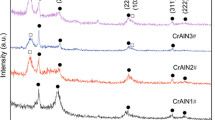Abstract
Copper coatings deposited on Al-6061 substrates by radio frequency magnetron sputtering, to prevent the retention and permeation of energetically implanted tritium in Al-6061, were evaluated by a variety of characterization techniques. The coatings, weighing in the 0.03 to 0.088 kg/m2 range, were smooth and had a fine grain structure. They contained the intermetallic phases Cu9Al4 and CuAl2 as well as copper. The fractions of Al and Cu in any coating increased and decreased, respectively, with increasing depth below the surface. Furthermore, the fractions of Al and Cu on the coating surface decreased and increased, respectively, with increasing coating weight. There was no texture or preferred orientation in the Cu phase of the coatings. A significant amount of oxygen was also detected at the original substrate surface. Residual stress measurements revealed that, in both Cu and CuAl2, the stresses in the coating plane were compressive, while the stress normal to the coating plane was zero in Cu but tensile in CuAl2. The shear-stress components were, however, negligible in both the Cu and CuAl2 phases. In the coating plane, the residual stress in Cu was always much smaller than that in the CuAl2 phase. Bond-strength measurements using tensile-pull testing provided a lower limit of the bond strength of about 2 MPa.
Similar content being viewed by others
References
Kirk-Othmer Encyclopedia of Chemical Technology, 4th ed., J.I. Kroschwitz, ed., John Wiley and Sons, New York, NY, 1991, vol. 8, pp. 1–30.
D.V. Winterfeldt and E. Schweitzer: Interfaces, 1998, vol. 28 (1), pp. 92–112.
S.A. Malloy, W.F. Sommer, R.D. Brown, J.E. Roberts, J. Eddleman, E. Zimmermann, and G. Willcutt: in Materials for Spallation Neutron Sources, M.S. Wechsler, L.K. Mansur, C.L. Snead, and W.F. Sommer, eds., TMS, Warrendale, PA, 1998, pp. 131–38.
D.F. Cowgill and R.A. Causey: J. Nucl. Mater., in press.
B.L. Doyle: J. Nucl. Mater., 1982, vols. 111–112, pp. 628–35.
K. Kamada, A. Sagara, N. Sugiyama, and S. Yamaguchi: J. Nucl. Mater., 1984, vols. 128–129, pp. 664–69.
S. Yamaguchi, S. Nagata, K. Takahiro, and S. Yamamoto: J. Nucl. Mater., 1995, vols. 220–222, pp. 878–82.
T. Tanabe, Y. Furuyama, N. Saitoh, and S. Imoto: Trans. Jpn. Inst. Met., 1987, vol. 28, pp. 706–14.
M.R. Louthan, Jr. and R.G. Derrick: Corros. Sci., 1975, vol. 15 (9), pp. 565–77.
Engineering Materials Handbook, C.L. Mantell, ed., McGraw-Hill, New York, NY, 1958, p. 36.41.
B. Window and N. Savvides: J. Vac. Sci. Technol., 1986, vol. A4 (2), pp. 196–02.
Annual Book of ASTM Standards, Section 2, Nonferrous Metal Products, ASTM, Philadelphia, PA, 1995, vol. 02.05, standard B253-87.
S. Craig and G.L. Harding: J. Vac. Sci. Technol., 1981, vol. 19 (2), pp. 205–15.
X-ray Powder Diffraction Files, ASTM, Philadelphia, PA, 1967, PDE Nos. 04-0787, 04-0836, 24-0003, and 25-0012.
L.G. Schulz: J. Appl. Phys., 1949, vol. 20, pp. 1030–36.
D.P. Tracy and D.B. Knorr: J. Electronic Mater., 1993, vol. 22 (6), pp. 611–16.
J.M.E. Harper, K.P. Rodbell, E.G. Colgan, and R.H. Hammond: J. Appl. Phys., 1997, vol. 82 (9), pp. 4319–26.
C.A. Chang: J. Appl. Phys., 1990, vol. 67 (1), pp. 566–69.
H. Krause and A. Haase: in Experimental Techniques of Texture Analysis, H.J. Bunge, ed., DGM Informationsgesellschaft Verlag, Oberursel, Germany, 1986, pp. 405–08.
I.C. Noyan and J.B. Cohen: REsidual Stress: Measurement by Diffraction and Interpretation, Springer-Verlag, New York, NY, 1987, p. 102.
D.Y. Jang, T.R. Watkins, K.J. Kozaczek, C.R. Hubbard, and O.B. Cavin: Wear, 1996, vol. 194, pp. 168–73.
I.C. Noyan and J.B. Cohen: Residual Stress: Measurement by Diffraction and Interpretation, Springer-Verlag, New York, NY, 1987, pp. 125–30.
Smithells Metals Reference Book, 6th ed., E.A. Brandes, ed., Butterworth and Company Ltd., London, 1983, p. 15–2.
L. Guillet and R. Le Roux: in Intermetallic Compounds, J.H. Westbrook, ed., Robert E. Krieger Publishing Company, Huntington, NY, 1977, p. 457.
M. Alam, D.E. Peebles, and J.A. Ohlhausen: J. Adhesion Sci. Technol., 1993, vol. 7 (12), pp. 1309–22.
M. Alam, Feng He, D.E. Peebles, J.A. Ohlhausen, and D.R. Tallant: J. Adhesion Sci. Technol., 1995, vol. 9 (6), pp. 653–79.
Author information
Authors and Affiliations
Rights and permissions
About this article
Cite this article
Inal, M.Y., Alam, M. Copper coatings for minimization of retention and permeation of implanted tritium in aluminum alloy 6061. Metall Mater Trans A 30, 2191–2199 (1999). https://doi.org/10.1007/s11661-999-0031-y
Received:
Issue Date:
DOI: https://doi.org/10.1007/s11661-999-0031-y




